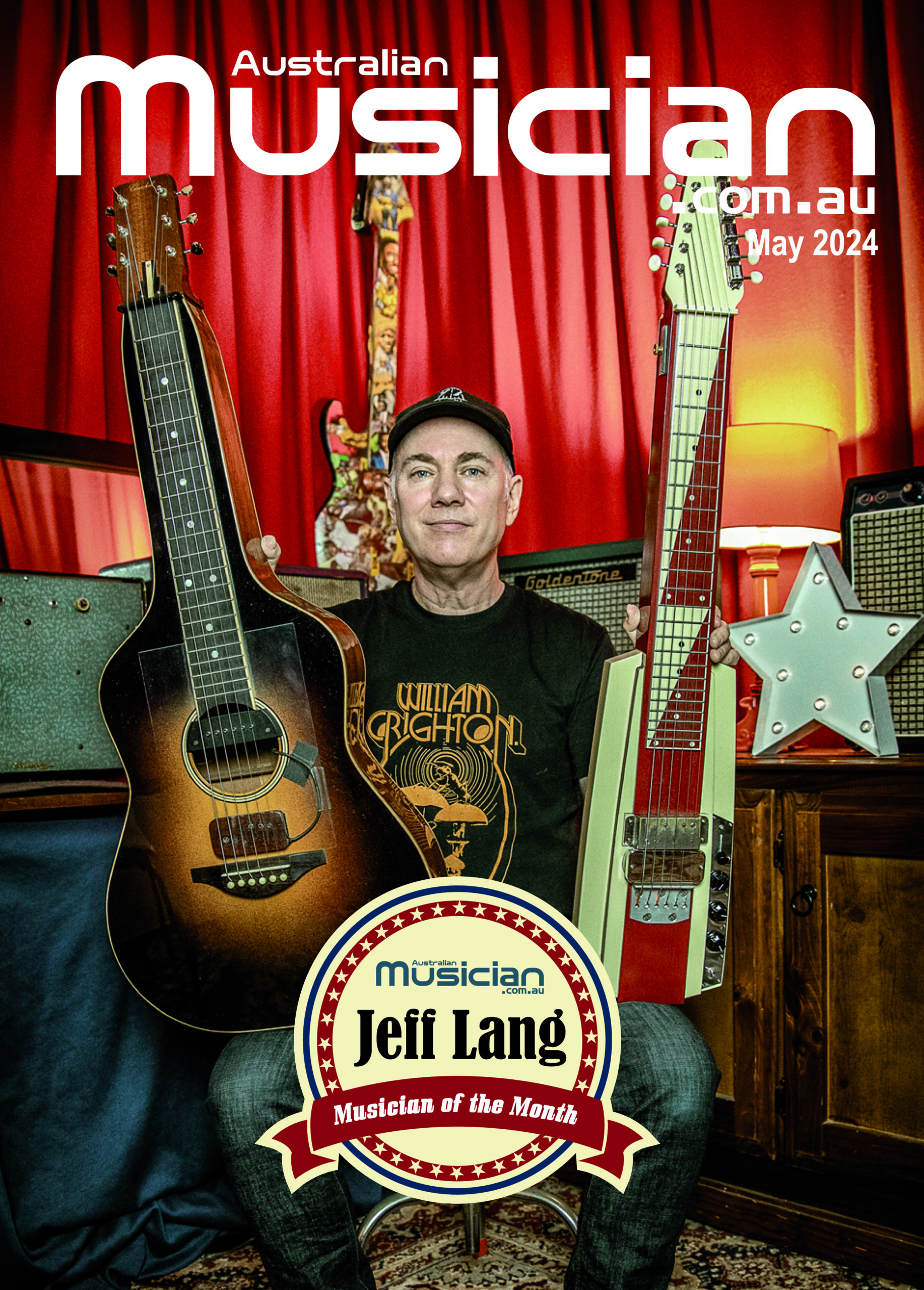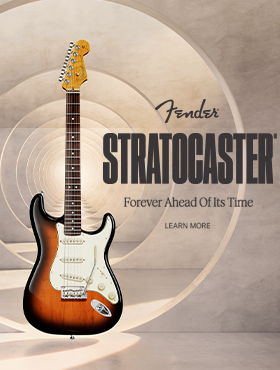JOE SATRIANI AT SOUNDCHECK
August 18, 2005 | Author: Joe Matera. Pics by Marty Williams
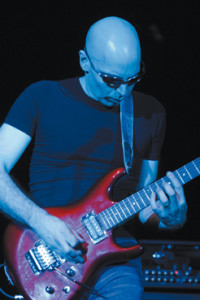 SOUNDCHECKIN’ WITH SATCH
SOUNDCHECKIN’ WITH SATCH
It’s late afternoon and I’m sitting in the foyer of a plush Melbourne inner city hotel talking to Joe Satriani’s manager Mick Brigden awaiting for Satch to show for our Australian Musician hook-up. Meanwhile I have a pleasant chat with Mick who is a veteran of the industry having worked with artists from Humble Pie to Mick Jagger. Brigden was also a long time business associate of the late great American promoter Bill Graham. About twenty minutes into our conversation, Joe finally surfaces and we take a comfy seat to commence the interview.
I ask Joe with such a hectic tour schedule, does he find there is a particular pre-show ritual he needs to follow in order to prepare himself for his intense shows? “I like to warm up for about 30 minutes before a show doing simple exercises” he answers. “I do this so I can get used to the structures and the bending stuff that I’ll be asking myself to play later in the show, but nothing too demanding.”
Later when the formal part of the interview is rapped up, we all board the Tarago and head for The Forum for Joe’s sound check. In the Tarago we are introduced to a couple of Joe’s touring band members: bass player Matt Bissonette – who is also the brother of acclaimed David Lee Roth and Steve Vai sticksman Gregg Bissonette – and drummer Jeff Campitelli.
Satriani’s shows have bordered on the three hour mark each night, with the set list reaching deep and far back into his extensive catalogue. So for his latest Australian tour — he was last here in 1992 — he is using a bunch of brand spanking new Peavey signature JSX heads and matching cabs. He has also brought along six Ibanez electric guitars; five JS1000s of varied colours and a JS1200.
Any particular reason why he has chosen these specific guitars?
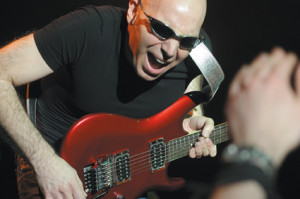 “Not really” he chimes. “They’re all almost exactly alike except for the red JS1200 one which has a different neck pick-up. Ever since I had a guitar stolen a number of years ago at a show I decided not to bring out old favourite guitars that were ten years old. What I did was I made sure that every six months we would take guitars right off the shelf and right out of the factory and put them into service. Most of them are a year or two years old at the most. I just keep replacing them. I have always got requests to donate guitars to different charities and things so most of them after I play them for a few tours, they go that way.”
“Not really” he chimes. “They’re all almost exactly alike except for the red JS1200 one which has a different neck pick-up. Ever since I had a guitar stolen a number of years ago at a show I decided not to bring out old favourite guitars that were ten years old. What I did was I made sure that every six months we would take guitars right off the shelf and right out of the factory and put them into service. Most of them are a year or two years old at the most. I just keep replacing them. I have always got requests to donate guitars to different charities and things so most of them after I play them for a few tours, they go that way.”
At the sound check Joe runs through a couple of the set’s songs before wavering off into an amazing improvisational jam with his band. His long time guitar tech Mike Manning proceeds to shows us the six Ibanez guitars.
Later I ask Joe if any of the guitars utilise specific tunings. “I have to settle on a drop D tuning guitar for a tour” he explains. “I find that that it is better to keep a guitar that’s got a different tuning to be left in that tuning for the entire tour as it settles in better. We kind of arbitrary make that one up as we go, you know which guitar we’re going to pick will that’ll stay as the drop D tuned guitar. Sometimes it could be something I haven’t played in awhile or it could be that I like the colour of it.”
With things so hectic I enquire whether the environment is conducive to songwriting and whether a lot of Joe’s inspiration and ideas spring from being on the road. “I’m not sure how ideas pop into my head” he says pausing for moment before continuing. “But I’m always an open book when it comes to that thing and I soak everything up as much as I can. But for sound check there is always an interview before and an interview after, or somebody taking pictures so it’s not a very private moment. So most of the songwriting ideas tend to come either in the hotel or on the bus.”
When it comes to his guitar playing influences, name checked are Jimi Hendrix, Jimmy Page, Jeff beck, Eric Clapton and Billy Gibbons. But he singles out jazz legend Wes Montgomery and fusion great Allan Holdsworth as being cornerstone markers towards his technique. In Montgomery case towards his fluid octave style and in Holdsworth case, his distinctive legato style that underlines most of Satch’s technique
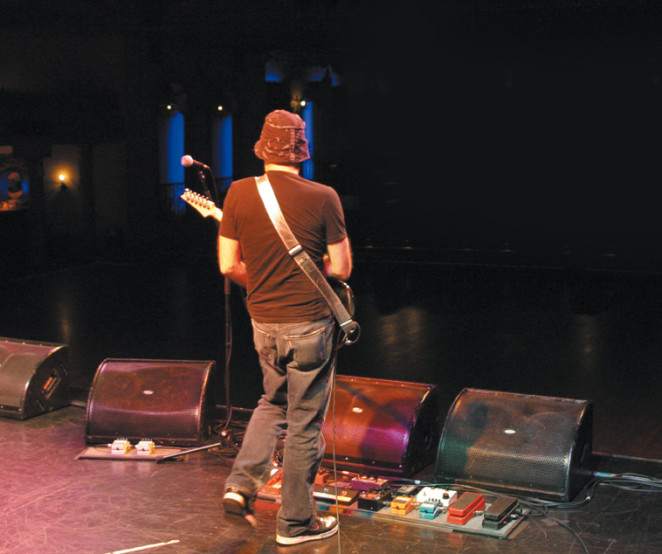 While on the subject of technique has Joe any advice forthcoming for aspiring guitarists that he can offer to help them with building their technique? “Just any set of exercises you get a hold of” he says matter of factly. “The key is to do them slowing with the idea that at the end of the day you’ve played any scale or exercise correctly more than you’ve played it incorrectly. To try and play something beyond your level for two hours everyday where you’d play it wrong most of time I don’t think that’s a good thing to thing to be doing. It’s like you’re creating experiences of making errors. The idea is to create an experience of not making errors so you have to slow down so that your body learns what it’s suppose to do when it’s doing it right.”
While on the subject of technique has Joe any advice forthcoming for aspiring guitarists that he can offer to help them with building their technique? “Just any set of exercises you get a hold of” he says matter of factly. “The key is to do them slowing with the idea that at the end of the day you’ve played any scale or exercise correctly more than you’ve played it incorrectly. To try and play something beyond your level for two hours everyday where you’d play it wrong most of time I don’t think that’s a good thing to thing to be doing. It’s like you’re creating experiences of making errors. The idea is to create an experience of not making errors so you have to slow down so that your body learns what it’s suppose to do when it’s doing it right.”
Pressed for time and due to hit the stage I wish him all the best for the show. As 8.00pm finally arrives Joe hits the stage to a sell-out Forum and fires off set opener Up In The Sky. For the next three hours, he mesmerises one and all with his dazzling and spectacular set. Tonight it’s Satch boogie to the tilt. Let’s hope his return won’t be another thirteen year wait…
SATCH’S PEDAL BOARD EXAMINED
When our resident photographer Marty Williams captured this pic of Joe Satriani’s pedal board at soundcheck, we thought we’d get longtime fan, and shredder himself, Craig McDonald to walk us through it. Looking at the picture we will start from left to right…
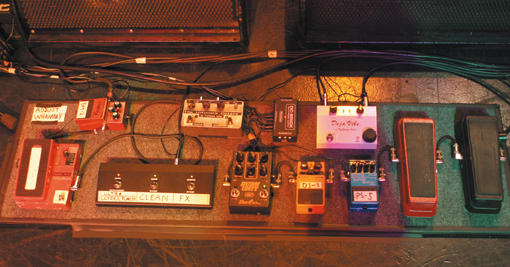
Pedal – 1 is the standard Digitech ‘Whammy’ pedal, which ‘Satch’ uses regularly. It basically controls the pitch of the note. It takes his guitar signal up (or down) an octave or two, whatever note he’s playing. It’s a great pedal as long as not overused. ‘Satch’ uses it sparingly and very well…
Pedal – 2 is a standard ‘Boss Delay’ pedal, which ‘Satch’ uses all the time… He always has that splash back of a small delay on almost everything he plays. He sometimes has 2 even 3 delays linked up to get that really dreamy delay sound, but on this occasion he only has the one delay pedal.
Pedal – 3 is just a channel selector, where ‘Satch’ can select ‘Ultra Crunch’, ‘Clean’ or turn the effects on or off bypassing all effects (which would mean he would be playing totally dry of effects) although he pretty much always has some type of effect on his guitar tone.
Pedal – 4 (above the channel selector) is a Fulltone brand pedal called the Ultimate Octave. This pedal has a very fat distortion/fuzz tone. It has a very active tone control and you can choose from “Fat/Bright” switch which takes the tone and completely changes it from a normally strong fat thick mid-range sound, to a tone completely scooped out with no mid-range and lots of hi end. It also has an ‘Octave Up’ feature, but because ‘Satch’ already has the Whammy, I would say he only uses this ‘Ultimate Octave’ pedal for the special Distortion/Fuzz tone he likes.
Pedal – 5 the ‘Burn Unit’ is another distortion pedal, the ‘Burn Unit’ is unusual where it is a mix between overdrive and distortion, offering plenty of sustain and harmonics (which ‘Satch’ loves) while still staying extremely defined. This unit has a special unique circuitry offering more dynamics to the player. You can have an explosive pick attack and still keep total note definition, also works great when playing full chords with absolute clarity..!! I would say that ‘Satch’ would use this pedal for a fat boost at times when needed or volume boost….
Pedal – 6 (top of board) is the DC Brick – power supply for all the pedals..
Pedal – 7 (bottom of board next to the ‘Burn Unit’) is the classic Boss DS-1 Distortion pedal. This is a classic distortion pedal, the first Boss distortion pedal, and ‘Satch’ has used this tone for many, many years, probably from the very beginning. It is really a basic rough aggressive sounding distortion tone, but ‘Satch’ uses it with style, and you can always detect his tone!!
Pedal – 8 (top larger pedal) is the Deja Vibe which produces a very heavily ‘phased/chorused’ tone, very vintage sounding 60’s tone. This pedal has a couple of different settings being the warm original 60′ uni-vibe grind, or the modern setting which is a much louder effect with more output. It is hard to tell which setting ‘Satch’ would use, but my guess would be the vintage 60’s tone.
Pedal – 9 (below the ‘Deja Vibe’) is the standard Boss Phase Shifter – or phaser, which we all Satch fans would know of. Used subtly, it makes his solos come alive.
Pedal – 10 (the red coloured Jim Dunlop pedal) – this is the Jim Dunlop ‘Rotovibe’ which is an electronic footpedal which simulates the tone of a rotating speaker, another vintage effect popularized by one of ‘Satch’s’ influences – Jimi Hendrix, as well as many other guitarists. This pedal had a bit of use on ‘Satch’s latest album, and was definitely used on the night of the gig. The pedal would control either the depth of the rotating speaker effect, or the speed. There is another control knob on the side which would do either the speed or depth..
Pedal – 11 is the standard Jim Dunlop 535Q ‘Wah – Wah’ pedal.’Satch’ is using the 535Q model wah, (as you can see the ‘Q’ frequency adjustment knob on the side of the pedal). This wah is different to the standard wah as it offers more control over the ‘wah’ tone. By adjusting the ‘Q’ control knob, you can have the wah sounding more of the higher frequencies, middle or lower, depending on what your tone requirements are. ‘Satch’ has been using the standard wah model for many years. So this model is just an upgrade for him I guess.
To summarise, ‘Satch’ appears to have 3 different distortion tones for his selection, 2 different chorus / phaser tones, a rotating speaker effect, wah effect, whammy effect and delay effect. Joe has definitely added a couple of new effects since his last tour here. I also noticed that ‘Satch’ likes to use a mix of vintage tones and effects with modern distortion tones. And obviously he only uses the few he needs at that particular time, but still with all those effects, he would have to be pretty quick on his feet!

